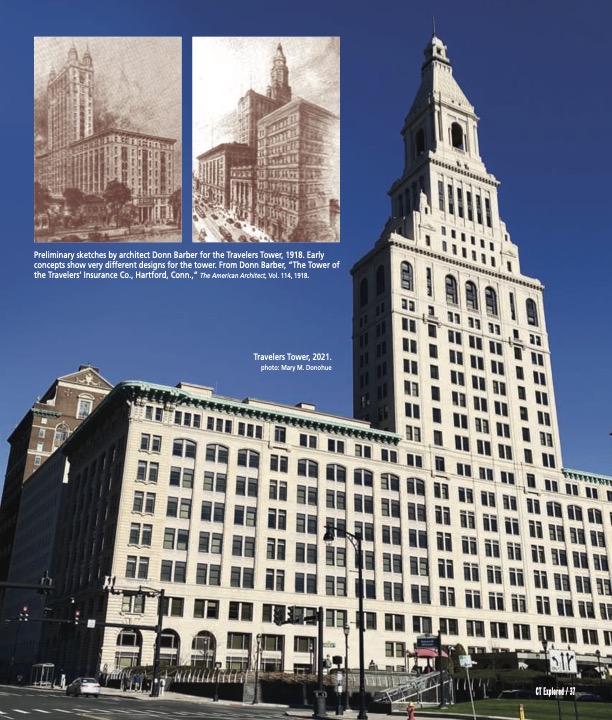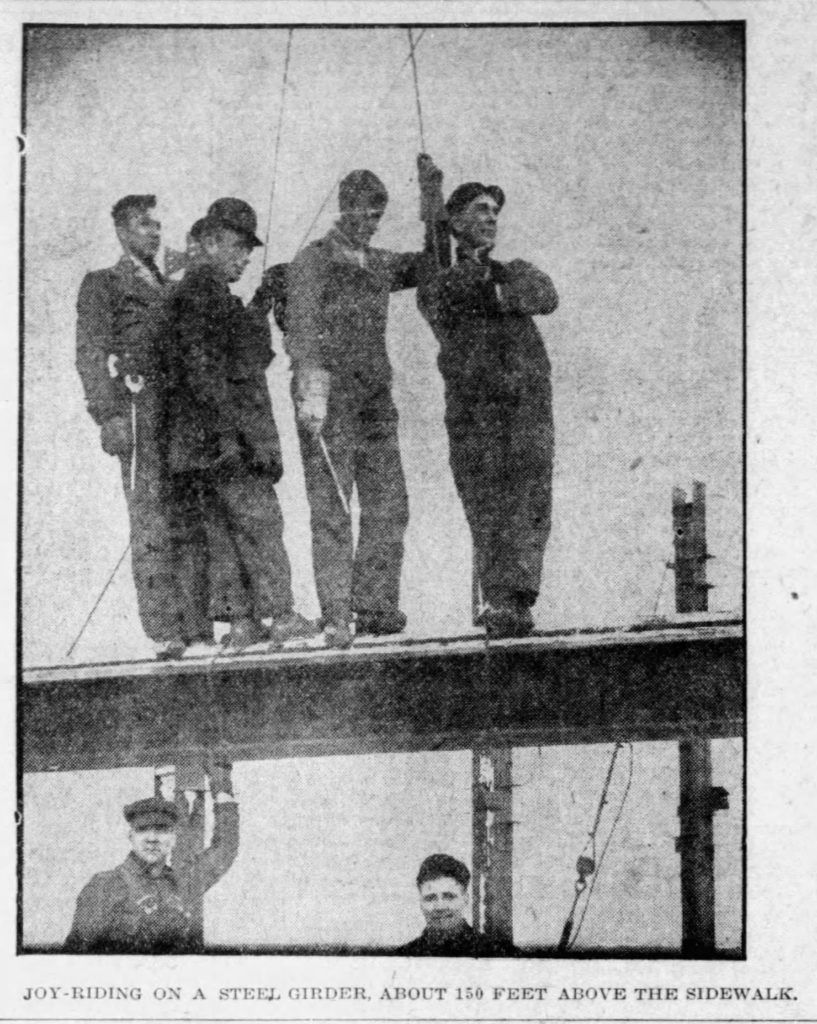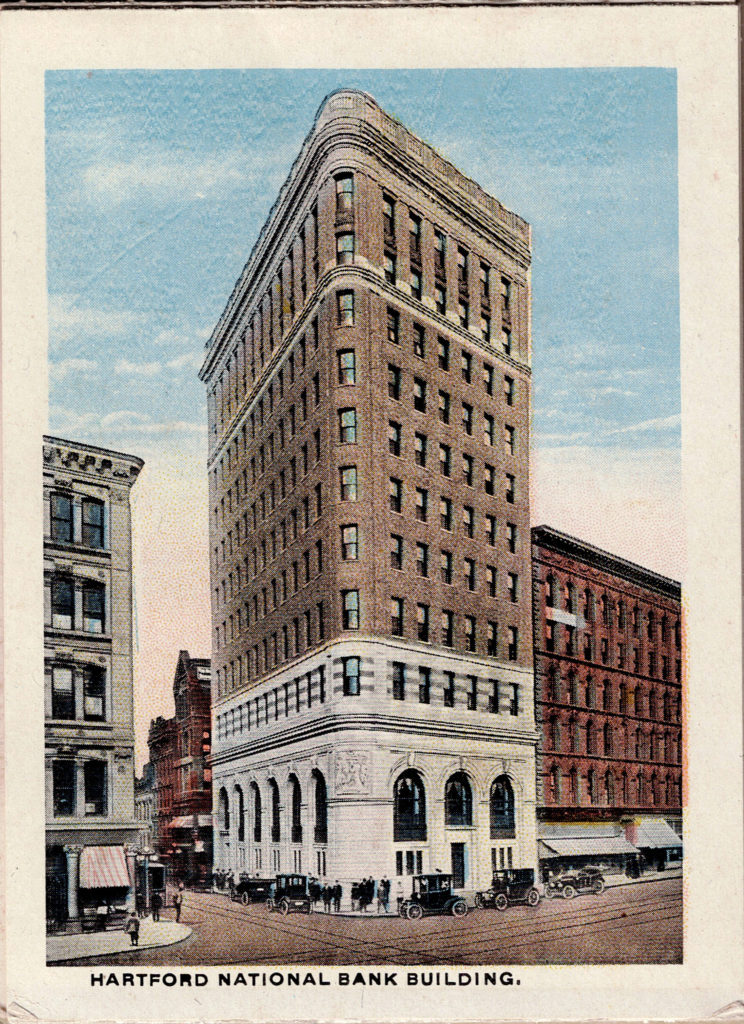
Travelers Tower, Hartford, 2021. photo: Mary M. Donohue. Insets: Donn Barber’s preliminary sketches for Travelers Tower, 1918. Donn Barber, “The Tower of the Travelers’ Insurance Co., Hartford, Conn.” The American Architect, vol. 114, 1918.
By Mary M. Donohue
(c) Connecticut Explored Inc. Spring 2022
Subscribe/Buy the Issue!
Donn Barber (1871 – 1925), a New York City architect, could be called the “Father of Hartford Skyscrapers.” He designed Hartford’s first skyscraper and another that reigned as the tallest in New England for decades. The first—the Hartford National Bank Building—was demolished in 1990, while the other—Travelers Tower—is still an icon of the Hartford skyline, one whose owner restored it in 2013. Barber and these two buildings not only dramatically changed Hartford’s skyline, they also played a role in advancing the city’s burgeoning white-collar banking and insurance industries in the early 20th century.
The Advent of Skyscraper Construction
As historians like David Nicholson-Cole chronicle, American businesses entered the 20th century with enthusiasm and vigor and built new corporate office headquarters to reflect that zeal. In urban centers, costly land prices encouraged architects to build up. Height, though, was constrained by practical considerations—namely, the number of flights of stairs that people could easily walk up, fire-safety considerations, and the limitations of available materials. As Nicholson-Cole reported in “The First Century of the Skyscraper: a Short History” (City Monitor, May 25, 2016),“ … a wave of new inventions [in the 1880s]… helped architects to build higher than ever before: Bessemer steel, formed into I-sections in the new rolling mills enabled taller and more flexible frame design than the cast iron of the previous era; the newly-patented sprinkler head allowed buildings to escape [a]strict height limit … imposed to control the risk of fire; and the patenting of AC electricity allowed elevators to be electrically powered and rise to ten or more stories.”
Chicago is credited as being home to the first skyscraper, the Home Insurance Building (1885), built with 10 stories to a height of 138 feet. Innovative Chicago architects began to use a metal framework of riveted girders that would support the building’s weight and a “curtain wall” of exterior cladding. By 1889 New York City had its first true metal-frame skyscraper, the Tower Building.
At the beginning of the 20th century, corporations began to erect monumental skyscrapers to associate their business with progress and success. As explained by Robert Adam in “How to Build Skyscrapers” (City Journal, Spring 2002), “The prestige of height was not enough; the buildings had to have the status of explicit historic architectural references, asserting the dignity of temples or palaces for commercial buildings—and, without irony, these had to be seen on a skyline anything up to 40 stories above the ground.” This would be true of Hartford’s first generation of skyscrapers.
Downtown Hartford Moves Skyward
Washington, D.C.-born Donn Barber received the best architectural training available and worked in some of New York City’s toniest architectural design firms. He was educated at Yale and Columbia universities and the Ecole des Beaux-Arts in Paris, France. The Ecole fostered a generation of American architects who designed in what became known in architecture and city-planning circles as the Beaux Arts style. This Classically-based style reshaped American taste, and its cities, at the beginning of the 20th century. Barber worked for Carrere & Hastings, Cass Gilbert (architect of Waterbury City Hall and New Haven’s Union Station and former owner/resident of Ridgefield’s Keeler Tavern Museum), and Lord & Howlett before opening his own office in 1900. [For more about Gilbert, see “Longer Lasting Than Brass: Waterbury’s City Hall Restored,” Fall 2011, “Glamour and Purpose in New Haven’s Union Station,” Spring 2013, and Grating the Nutmeg episode 103: “Cannonballs & Skyscrapers – Keeler Tavern.”)
Before Barber was commissioned to build Hartford’s first skyscraper, he was hired to design the new state library. Barber’s brand of Beaux Arts design was just what Connecticut State Librarian George Godard had in mind for the 1906 library building. In fact, recently-retired Connecticut State Librarian Kendall F. Wiggin, in his Fall 2010 Connecticut Explored story “Connecticut State Library: George Godard Gets His Building,” notes that “The Beaux-Arts style of architecture, highlighted at the 1893 World Columbian Exposition and at the core of the City Beautiful movement, was the only style the [State Library] Commission would consider for the design competition that led to the selection of Donn Barber of New York City and Edward T. Hapgood of Hartford as the architects for the project.” A $1.6 million commission, the Italian Renaissance-inspired building houses the state’s archives, supreme court, and memorial hall. The Hartford Courant declared it “one of the most beautiful structures in the country” (12/17/1910). Barber would go on to design the Hartford National Bank in 1911, the unrealized Charter Oak Bank Building in 1914, the Travelers Tower in three stages between 1906 and 1919; the Hartford Times Building in 1920, and the Travelers Insurance Co. building at Grove and Prospect streets in 1921.
Hartford’s First Skyscraper
As Daniel Sterner amply illustrates in Vanished Downtown Hartford (The History Press, 2013), at the beginning of the 20th century Hartford was awash with downtown banks and insurance companies. The Hartford National Bank, a 115-year-old local banking institution, bought the building at the northwest corner of Asylum and Main streets in 1907, and in 1911 announced that it would build the city’s first skyscraper on this very prominent corner. Fresh from his design triumph at the Connecticut State Library, Barber won the commission. The Hartford Courant declared on June 9, 1911 that it “will represent his best work” and that the banking floor would be very similar to Memorial Hall at the State Library.
Not everyone was happy, however, that both a New York City architect and an out-of-state construction company had been chosen to build the city’s first skyscraper on one of downtown’s most prominent corners. On July 11, 1911, the Hartford Inter-State Local Assembly of Inter-State Builders, Contractors and Dealers Association took out a full-page ad in The Courant with the headline “Hartford Building Interests Ask for Fair Play.” The ad asserted that “millions of dollars that should have remained in Hartford have gone out of Hartford” and demanded that more construction projects be awarded to Hartford architects and builders. Barber was specifically called out. The ad reproduced a letter written on Barber’s company letterhead that asked a local company to submit its qualifications for the project. That image was accompanied by a letter in response from Charles B. Andrus & Son, a local construction company, that argued that, although it had never built a skyscraper, the company was more than capable of doing so. The ad’s sentiment was “New York needs Hartford contractors more than Hartford needs New York’s.”

“Joy-Riding on a Steel Girder About 150 Feet Above the Sidewalk,” Hartford National Bank Building, The Hartford Courant, December 6, 1911
Despite the high-profile protest, work went ahead as planned, and five weeks into construction, 9 of 11 stories of the steel frame had gone up. The Courant sent a reporter and photographer to the buzzing construction site. Their story on December 6, 1911 presented a revealing look at the work of the structural ironworkers. With construction taking place 100 feet or more in the air without safety harnesses or fall nets, the reporter reported one person’s opinion “that it was an even bet that at least three men would be killed on the building.” This was no idle speculation. As historian Jim Rasenberger explains in High Steel: The Daring Men Who Built the World’s Greatest Skyline (HarperCollins, 2004), “Between 1910 and 1914, according to the Bureau of Labor Statistics, structural ironworkers … [had]well over a third of the workforce killed or injured within four years. ‘The erection of structural steel,’ concluded the study’s authors, ‘must be recognized as one of the most … hazardous industrial operations’ in the country.”
According to The Courant story, “The ladders rose almost perpendicularly and were shaky at times. …The building at present is no place for a nervous man… .” The photographer captured two striking images of the steel workers. The first, captioned “Joy-Riding on a Steel Girder about 150 feet Above the Sidewalk,” shows four men atop a beam in casual poses and one in a bowler hat riding a steel beam as it was hoisted to the top of the building. “In their trade,” the story commented, “a man must depend on the agility of his limbs as well as the accuracy of his eyes to keep his wife … from collecting on his life insurance policy.”
The second photo depicts a worker positioned on a vertical column while possibly pounding in a red-hot rivet. Erecting the frame involved a coordinated effort to raise the steel girders using steam-powered cable drums on the ground to wooden derricks at the top of the building. The steel girders would be swung into position and a worker called a “setter” would slip in the first bolts before a riveting team did its work. The hot rivets would be thrown to a worker and pounded into a hole on the side of the girder. Then a worker would use a pneumatic hammer to, as Rasenberger describes, “smash the semi-molten metal into a button flush against the shank of the rivet.” The Courant reporter concluded that, “Certainly Hartford’s first skyscraper is being built with the most modern methods.”
On September 20, 1912 The Courant reported that the Hartford National Bank now had its handsome new home. “There is no question that the new skyscraper … is the most striking building upon the landscape of … Hartford. The height is the most striking characteristic.” The building’s design followed the practice of dividing the exterior elevation into three parts, like a classical column, with an elaborate base, plain shaft, and decorated roofline. In addition to the building’s height, it had what was considered fireproof construction and two passenger elevators—all the elements of a skyscraper.
The bank occupied the first two floors, including an ornate banking floor, impressive lobby, president’s office, and a board of directors’ room on the first floor. The bank offices above were equipped with the latest features to improve the efficiency of the burgeoning number of white-collar workers, including secretaries, stenographers, clerks, accountants, and mail-room staff. The open floor plan had rows of desks. Time-saving features such as pneumatic tubes that whisked paperwork between offices, mail chutes, file rooms, telephones, and messenger call services all contributed to the development of the modern office. The upper floors had 99 income-producing offices, enabling the bank to further profit from its new building by renting them to other businesses.
The Tallest in New England
Travelers Tower on Hartford’s Main Street has an unusual construction story. In 1905 The Courant announced that the company board of directors had chosen Donn Barber and Edward T. Hapgood as the architects of their new building—a five-story building; the tower would come later. Barber and Hapgood had been chosen from a field of candidates that included four New York City firms, one Boston firm, and one firm from Hartford.
Soon after the building’s 1906 completion, more offices were needed. By 1913 Travelers constructed an addition on the south side, creating what can now be recognized as the “base” for the tower that was to come. The 1906 and 1913 portions of the building were identical, with a heavy rusticated stone arcade at the ground floor level, five floors of offices, and a massive overhanging bracketed cornice. When the addition opened in 1913, it was anticipated that there would be enough office space for employees for years. But, as Tracey Wilson reports in “Women in the Workplace: From Steno Pool to Factory Floor,” (CTExplored, Winter 2013/14),“The Travelers ‘Home Office Census’ of 1971 shows the number of home-office employees peaking at more than 5,800 in 1930, having grown from about 900 workers in 1913 to more than 3,000 in 1919. Business was booming.”
Once again, Barber received the commission. The new office space was to be a skyscraper tower above the existing 1906/1913 buildings. This was an uncommon approach. Monumental office buildings across the country were conceived of as a single building, notes Mark Houser in MultiStories, 55 Antique Skyscrapers & the Business Tycoons Who Built Them (Mark Houser, 2020).
In The American Architect (Vol. 114, Part 1, 1918), Barber described the style of the new tower as “free Renaissance.” The 527-foot tower is steel-framed and sheathed in Westerly granite. Quarries owned by James Goodwin Batterson, founder of The Travelers Insurance Company in 1863, supplied the stone for the tower. Barber noted that the tower was unusual in that it is not a straightforward square building until it reaches 400 feet in height, with flush, cliff-like elevations on the north and south sides. Building materials including the structural steel were ordered before the onset of World War I so that construction could begin in 1917, uninterrupted by war shortages. Staff continued to work in the offices in the 1906/1913 buildings throughout construction.
When it opened in 1919 Travelers Tower was the tallest building in New England, the seventh tallest in the world, and the first commercial building outside New York City to rise higher than 500 feet, according to Emporis, a company that collects data on buildings of high public and economic value (see emporis.com/buildings/122589/travelers-tower-hartford-ct-usa). It remained the tallest in New England until 1964 and the tallest in Connecticut until 1984. With the exception of two banks with offices on the ground floor, the building was occupied entirely by Travelers home office employees. Departments were organized by floor, and an electric dumbwaiter moved mail. The telephone switchboard had 18 operators. Six elevators moved passengers to the 21st floor, and two continued to the 24th floor. A beacon of light and a radio station were added to the tower in 1919.
The fate of these two early skyscrapers diverged markedly. The Hartford National Bank building went through a series of owners as local banks merged. It, along with half a block of other historic buildings, was demolished over vehement protests by historic preservationists in 1990 for a development that never happened. Thirty-one years later, the area is still a vacant surface parking lot.
Travelers Tower received several additions but is still occupied by its namesake company. In 2013 the building received, according to a Courant story on August 8, 2013, a $30 million exterior restoration that repaired the granite stonework and cleaned and repainted the cast-iron spandrels between the windows. Travelers Tower has been much photographed since it was completed and still shines as the most recognizable landmark of Hartford’s skyline.
Mary Donohue serves as assistant publisher of Connecticut Explored, and is co-producer of Grating the Nutmeg, the podcast of Connecticut history. She last wrote “Building Art of Clay,” Fall 2021.
Explore!
Connecticut State Library: “George Godard Gets His Building,” Fall 2010
GO TO NEXT STORY
GO BACK TO SPRING 2022 CONTENTS

